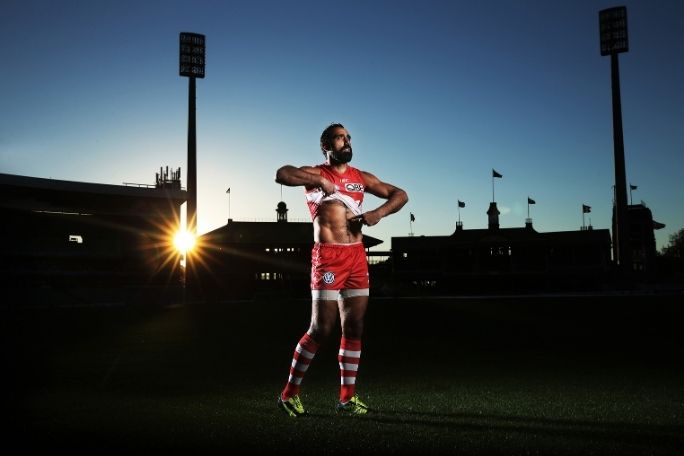Lesson summary
Retired AFL star Adam Goodes is known to many for his resilient journey in the face of detrimental treatment by AFL spectators and the media beginning in 2013.
In this lesson, students will explore the media response to the celebration dance performed by player Adam Goodes during an Indigenous Round match. They will explore objective and subjective language, identifying the use and impact of each in the commentary viewed. They will then write their own article in response to the issue, controlling their language use in order to ensure they write in an objective manner. They then reflect on and discuss the ethical responsibilities of the media.
Learning intentions:
Students understand...
- language features that influence audiences
- the difference between objective and subjective language
- the importance of identifying all relevant information before drawing conclusions.
Success criteria
Students can...
- provide examples of objective language from the videos viewed
- explain the impact of objective language
- provide examples of subjective language from the videos viewed
- explain the impact of the subjective language
- make use of objective language to create a responsible news article.
Lesson guides and printables
Lesson details
Curriculum mapping
Australian curriculum content descriptions:
Year 6 English:
- Compare texts including media texts that represent ideas and events in different ways, explaining the effects of the different approaches (ACELY1708)
- Understand the uses of objective and subjective language and bias (ACELA1517)
- Analyse how text structures and language features work together to meet the purpose of a text (ACELY1711)
- Use comprehension strategies to interpret and analyse information and ideas, comparing content from a variety of textual sources including media and digital texts (ACELY1713)
- Analyse strategies authors use to influence readers (ACELY1801)
- Plan, draft and publish imaginative, informative and persuasive texts, choosing and experimenting with text structures, language features, images and digital resources appropriate to purpose and audience (ACELY1714)
- Re-read and edit students’ own and others’ work using agreed criteria and explaining editing choices (ACELY1715)
Syllabus outcomes: EN3-2A, EN3-3A, EN3-5B
General capabilities: Literacy, Critical and Creative Thinking, Personal and Social Capability, Ethical Understanding, Intercultural Understanding
Cross-curriculum priority: Aboriginal and Torres Strait Islander Histories and Cultures (OI.5, OI.6, OI.9)
Relevant parts of Year 6 English achievement standards:
By the end of Year 6, students understand how the use of text structures can achieve particular effects. They analyse and explain how language features, images and vocabulary are used by different authors to represent ideas, characters and events.
Students compare and analyse information in different and complex texts, explaining literal and implied meaning. They select and use evidence from a text to explain their response to it. They listen to discussions, clarifying content and challenging others’ ideas.
Students understand how language features and language patterns can be used for emphasis. They show how specific details can be used to support a point of view. They explain how their choices of language features and images are used.
Students create detailed texts elaborating on key ideas for a range of purposes and audiences. They make presentations and contribute actively to class and group discussions, using a variety of strategies for effect.
This lesson is part of the wider unit of work: The Final Quarter – Exposing Truth. Embracing Diversity – Years 5 & 6
Time required: 90 mins
Level of teacher scaffolding: High – facilitate class discussion with sensitivity to students’ feelings and experience (in relation to racial discrimination)
Resources required
- Adam Goodes Profile – digital copy
- Device capable of presenting a video to the class
- Glossary of Key Terms (optional)
- Handling Sensitive Topics and Issues (optional)
- Student Worksheets – one copy per student
Skills
This lesson is designed to build students’ competencies in the following skills:
- Community engagement
- Communication
- Critical thinking
- Cultural understanding
- Empathy
- Ethical understanding
- Social skills
Additional info
Using only archival footage aired at the time, The Final Quarter holds a mirror to Australia and is an opportunity to reconsider what happened on and off the football field. Learn more about the film here.
We highly recommend that students view the film in its entirety before participating in subsequent lessons.
Our Watching the Film lessons are designed to support you in facilitating this process. Given the content, it is also important for teachers to communicate with parents and guardians of Aboriginal and Torres Strait Islander students before playing the film and/or engaging with the teaching and learning resources.
Note: This film may not be suitable for viewing by all young people. Teachers are advised to use their discretion when deciding whether to show this film. If teaching in a context with a high proportion of Aboriginal and Torres Strait Islander children, it is imperative that guidance is sought from the Principal and Aboriginal Education Officer (or equivalent) prior to screening the film.


Welcome back!
Don't have an account yet?
Log in with:
By signing up to Cool.org you consent and agree to Cool's privacy policy to
store, manage and process your personal information. To read more, please see
our privacy policy here(Opens in new tab).
Create your free Cool.org account.
Many of our resources are free, with an option to upgrade to Cool+ for premium content.
Already have an account?
Sign up with:
By signing up to Cool.org you consent and agree to Cool's privacy policy to
store, manage and process your personal information. To read more, please see
our privacy policy here(Opens in new tab).